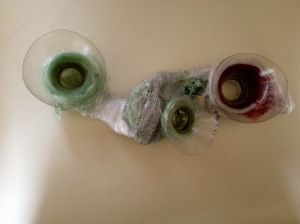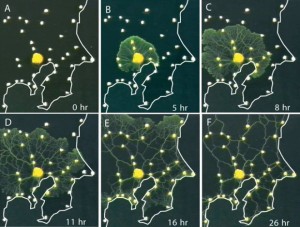biomemtic design-ish
The final unveiling tba/stay tuned:
Norah and I are in the process of creating a silicone sleeve for the OctoArm. We texturized the mold using hardware (bolts, etc), and are planning on coloring the sleeve with thermochromic paint as well as potentially gloss and/or dye…
This is the contraption we created for the outer mold:

What does an octopus feel /look like? /Material Case Studies:
Created using soda plastic bottles tops, metal wire, and plastic grocery bags for color.

Experimenting with camouflage with an inner suction mirror.

Texturized using actual octopus/calamari, and colored with blue food coloring and yellow alginate. (lesson learned: silicone is extremely hard to mold on moist objects )

Texturized from metal wire, colored with yellow food coloring, and painted with a high gloss finish. (it is now also colored with mold.. which adds a certain organic bonus!)

Suctions were attempted/failed:

////////////////////////////////////////////////////~~~~~~~~~~~~~~~~~~~~~~~~~~~~~~~~//////////////////////////////////
“OCTOPI
(/ˈɒktəpʊs/ or /ˈɒktəpəs/; plural: octopuses, octopi, or octopodes)!
- “cuttlefish, and squid—may be able to see with their skin.”
thinking about mimicking skin sensory system>
“A blind person walking down the street with a cane is using sensory substitution,”
http://www.nei.nih.gov/news/briefs/weihenmayer.asp
- “Hanlon’s team discovered that the bottom layer of octopus skin, made up of cells called leucophores, is composed of a translucent, colourless, reflecting protein. “Protein reflectors are very odd in the animal kingdom,” says Hanlon, who is a zoologist.
What’s even more odd is just how reflective these proteins are — they reflect all wavelengths of light that hit at any angle. “This is beautiful broadband reflection,” Hanlon told the Materials Research Society at their meeting in Boston last month.”
-http://www.nature.com/news/2006/061204/full/news061204-14.html
- “The secret sauce for the octopus’s color-changing talent is it schromatophores”
“Each chromatophore is independently controlled by the nervous system, which enables a high degree of complexity in the display of colors. ”
“An ink sac is located near its digestive system, and when necessary, the octopus can eject ink out of the sac along with a burst of water from the funnel. The combination creates a black cloud.”
possible brainstorming materials:
mirrors
cameras
flur
{AWWW snap> JELLY FISH:
“The male pillow octopus may be small, but he’s scrappy. What he lacks in size, he makes up for in creative defense tactics. He’s been known to rip off the poisonous tentacles of Portuguese man-of-war jellyfish and wield them as make-shift swords to ward off predators. He can do this because he himself is immune to their sting.”}
~~~~~~~~~~~~~~~~~~~~~~~~~~~~~~~~~~~
~~~~~~~~~~~~~~~
~~~~~~~~~~~~~~~~~~~~~~~~~~~~~~~~~/////////////////^^^^^^^^^^^^^^^^^^^^^^^^^^^^^^^^^^|||||||\\\\\\\\\\\\\\\\\\\\\\\\\\
thinking about a group of bugs landing on a fixed object, after putting together the joint movemnt/wave processing sketches and adding some inversions. it produces some nice symbiotic/cyclical something…)
int w; // Width of entire wave in the screen
float theta = 0.0; // Start angle at 0
float amplitude = 75.0; // Height of wave in pixels
//float period = 500.0; // How many pixels before the wave repeats
float dy = 0.5; // Value for incrementing X, a function of period and xspacing
float[] yvalues; // Using an array to store height values for the wave
int numServos = 16;
float yspacing; // How far apart should each horizontal location be spaced
int circleSize = 5;
int padding = 200;
float speed = 0.5;
int segmentLength;
PVector shoulder;
PVector elbow;
PVector target;
import processing.serial.*;
Serial myPort; // Create object from Serial class
void setup() {
yspacing = (circleSize * numServos + numServos * padding)/height;
size(700, 640);
smooth();
w = width+16;
//dx = 0.5;//(TWO_PI / period) * xspacing;
yvalues = new float[numServos];
segmentLength = int(width/5);
shoulder = new PVector();
elbow = new PVector();
target = new PVector();
shoulder.x = width/2;
shoulder.y = height/2;
String portName = Serial.list()[0];
println(Serial.list());
myPort = new Serial(this, portName, 9600);
}
void draw() {
dy = map(mouseY, 0, width, 0, 0.5);
//speed = map(mouseY, 0, height, 0, 0.1);
amplitude = map(mouseX, 0, height, 0, 100);
background(255);
calcWave();
renderWave();
amplitude = 125;
//period = map(mouseY,0, width, 0, 5);
// saveFrame(“images/###.png”);
target.x = mouseX;
target.y = mouseY;
PVector difference = PVector.sub(target, shoulder);
float distance = difference.mag();
// don’t go furthter than the full arm length
float c = min(distance, segmentLength + segmentLength);
float b = segmentLength;
float a = segmentLength;
float B = acos((a*a + c*c – b*b)/(2*a*c));
float C = acos((a*a + b*b – c*c)/(2*a*b));
// reduced form:
//float B = acos(c/(2*a));
//float C = acos(1 – (c*c)/(2*segmentLength*segmentLength));
// angle between
float D = atan2(difference.y, difference.x);
float E = D + B + PI + C; // Pi is 180 degrees in rad
elbow.x = (cos(E) * segmentLength) + shoulder.x;
elbow.y = (sin(E) * segmentLength) + shoulder.y;
target.x = (1/cos(D+B) * segmentLength) + elbow.x;
target.y = (1/sin(D+B) * segmentLength) + elbow.y;
PVector hip = new PVector(shoulder.x, shoulder.y – 50);
PVector torsoOrientation = PVector.sub(shoulder, hip);
PVector upperArmOrienation = PVector.sub(elbow, shoulder);
float shoulderAngle = angleBetween(shoulder, elbow, torsoOrientation);
float elbowAngle = angleBetween(target, elbow, upperArmOrienation);
println(“s: ” + shoulderAngle + “\te: ” + elbowAngle);
byte out[] = new byte[2];
out[0] = byte(int(shoulderAngle));
out[1] = byte(int(elbowAngle));
myPort.write(out);
stroke(255);
fill(240, 0, 0, 200);
// ellipse(1/shoulder.x, 1/shoulder.y, 20, 20);
ellipse(elbow.x, elbow.y, 15, 15);
ellipse(target.x, target.y, 10, 10);
stroke(255);
strokeWeight(2);
line(shoulder.x, shoulder.y, elbow.x, elbow.y);
line(elbow.x, elbow.y, target.x, target.y);
}
float angleBetween(PVector one, PVector two, PVector axis) {
PVector v = PVector.sub(two, one);
return degrees(PVector.angleBetween(v, axis));
}
void calcWave() {
// Increment theta (try different values for ‘angular velocity’ here
theta += speed;
// For every x value, calculate a y value with sine function
float y = theta;
//println(x);
for (int i = 0; i < yvalues.length; i++) {
println(yvalues.length);
yvalues[i] = amplitude*1/tan(y);//this is the crucial line
y+=dy*1/sin(y);//x is the angle that is being added to in order to cycle through
// println(“dx:” +dx+” speed:”+speed+” amplitude:”+amplitude+” theta:”+theta);
//print(yvalues[i]+90+” “);
}
println();
}
void renderWave() {
noStroke();
fill(0,0,0,140);
// A simple way to draw the wave with an ellipse at each location
for (int y = 0; y < yvalues.length; y++) {
ellipse(y*yspacing, height/2+yvalues[y], 30, 30);
}
}
assignment duex (2)
thinking about sound as it relates to communication/visualization.. for example what could be learned by studying whale songs/bird songs/ our songs through a different medium than air.
1) who is the user? = us
2) what is the task accomplished? = a new way of thinking about noise/ communication
3) why is it unique? = I’m not sure it is… i know cymatics have been used in the past to play with different frequencies, but contextualizing animal communication in this fashion could be interesting
4) outline the technological fabrication methods that you would use to accomplish this? = it wouldn’t need to be a complicated system to start simply recordings and an amp/stereo with a conductor to visualize the sound
— —– ^ — ——————————————————————–^^^^^^——————————-^^^^^^^^^^^^^^^^^————————^^^^^^^
assignment(S) 1!
jellyfish and plastic bags are both becoming ubiqitous in the ocean/ both seemingly toxic for us.. this attempts to mimic jellyfish’s movement in the water (via wind)/ and how they cast shadows. the movement is currently random, but is seeking breath in the future. by biking with it and stopping and starting i was playing with that breath, and how my movement might affect that.
“Plastic bags and oil platforms aren’t a problem — jellyfish think these unnatural surfaces make great breeding grounds.”
Read more: http://www.businessinsider.com/jellyfish-are-freaks-of-nature-that-are-going-to-take-over-the-worlds-oceans-2013-9#ixzz2eWeL1J4E
************************************
biomimetic yes:
“A new model based on the simple rules of the slime mold’s behavior may lead to the design of more efficient, adaptable networks, the team contends.”
http://www.wired.com/wiredscience/2010/01/slime-mold-grows-network-just-like-tokyo-rail-system/

biomimetic not so much:
Lamborghini, this is purely because I don’t like the aesthetic and the idea that its used in a high synthetic otherwise unconsidered form.
************************************************
Readings:
1. Is this a complete definition of what you think of as biomimicry? Does this definition define nature in an appropriate way? What might be lacking in Janine Benyus’ definition of “life’s principles”?
It is fairly general to be a complete definition of biomimicry. The use of “nature” is also potentially problematic. Thinking about nature as something outside of us (which this seems to allude to) suddenly makes it “other.” When in a sense everything is natural, humans are not separate, nor are built environments. Also, in terms of “life’s principles,” what makes something enhance the biosphere, or make something “life friendly.”
2. Is the metaphor of biology to engineering systems pertinent and relevant, as Bar-Cohen compares them? Can you consider further advantages to biomimetic design than the properties of biomimetic principles that Bar-Cohen defines?
I think so, however he tends to oversimplify and again generalize processes. “Bees create the honeycomb for its efficient packing configuration.” What are the other considerations for why they create a honeycomb?
“The fabrication of biologically derived materials produces minimum waste and no pollution.” How is biologically derived being defined? How is waste defined, carbon cycle, recycle, etc?
And, while less pertinent to engineering there also was minimal if any discussion of the aesthetic/visual implications.
3. What are the implications for designing for animal-interaction? What is the differences / similarities between designing for non-human users rather than designing inspired by non-human organisms? Where does “living design” fit in all of this?
“The idea of an “interspecies Internet”, connecting us with not only other human beings, but really the entire planet (TED Blog, 2013a).”
It may be connecting us to them but does it work visa versa? The entire tone of this article highlights not only the implications of designing for animal-interactions but the lack of consideration within that process. There tends to be an assumption that animal happiness and welfare is easily quantifiable. Are they really happy?
“Metazoa Ludens have wanted to make it possible for the animal to “join the human in electronic gaming to pro- duce happy and well-trained canines and humans” We are defining happiness by our understanding of it, that is problematic.
Also, “he points out animals have cognitive models very different from humans and it is simply unreason- able for dogs to “be expected to understand that pressing a button is the same as interacting with its owner.” Because maybe dogs realize it’s not?
Or as exemplified in the chart “can voice what she he her wants; animals: no”
The discussion of the chicken potentially enjoying the jacket was also confusing. If you think about ourselves endorphines are realized when we drink alcohol, if we were observed there would be signs of enjoying it. However, it highlights the line of what is good for something and what is enjoyable.











